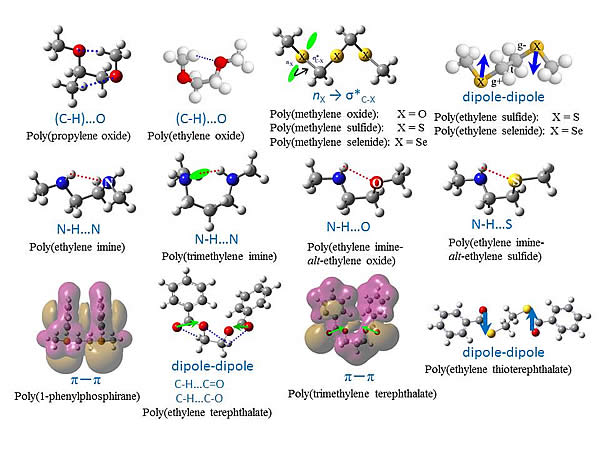at National Institute of Materials and Chemical Research and Chiba University
<1993 - Present>
Weak Attractive Interactions due to HeteroatomsPublication List
We have challenged to elucidate structure-property-function relationships of existing polymers and, furthermore, to predict higher-order structures, physical properties, and functions of not-yet-synthesized polymers from the primary structure. The latter procedure is often called “molecular design of polymers”. Ab initio molecular orbital (MO) calculations on small model compounds with the same skeletal bod sequence as the target polymer includes give conformational energies and geometrical parameters of the polymer and reveal “weak attractive interactions due to heteroatoms”. The MO data have always been verified by, e.g., precise NMR experiments and directly introduced into the refined rotational isomeric state (RIS) scheme (i.e., statistical mechanics of polymeric chains) to yield characteristic ratio, its temperature coefficient, configurational entropy, configurational energy, etc. We have designated the computational technique as “ab initio statistical mechanics of polymers”. By the methodology, we have so far studied the following polymers:

Polyether: poly(methylene oxide); poly(ethylene oxide); poly(trimethylene oxide); poly(propylene oxide); poly(tetramethylene oxide)
Polyamine: poly(ethylene imine); poly(trimethylene imine); poly(N-methylethylene imine)
Polyphosphine: poly(1-methylphosphirane); poly(1-phenylphosphirane)
Polysulfide: poly(methylene sulfide); poly(ethylene sulfide); poly(trimethylene sulfide); poly(propylene sulfide)
Polyselenoether: poly(methylene selenide); poly(ethylene selenide); poly(trimethylene selenide)
Copolymer: poly(ethylene imine-alt-ethylene oxide); poly(ethylene imine-alt-ethylene sulfide); poly(ethylene oxide-alt-ethylene sulfide)
Polyester (aromatic): poly(ethylene terephthalate); poly(trimethylene terephthalate); poly(butylene terephthalate); poly(ethylene naphthalate)
Polyester (aliphatic): poly(L-lactide); poly(DL-lactide); poly((R)-3-hydroxybutyrate); poly(ethylene succinate); poly(butylene succinate)
Polyamide: aromatic polyamide 2T; aromatic polyamide 3T; polyglycine; polyalanine; polyβ-peptides
Polythioester: poly(ethylene dithioester); poly(trimethylene dithioester); poly(tetramethylene dithioester); poly(pentamethylene dithioester)
Polythioamide: aromatic polythioamide 2T; aromatic polythioamide 3T; polythioglycine; polythioalanine; polyβ-thiopeptides
Polydithioester: poly(ethylene tetrathioester); poly(trimethylene tetrathioester); poly(tetramethylene tetrathioester); poly(pentamethylene tetrathioester)
Poly(ester amide): poly(oxyethylene-iminosuccinyl)
Polyurethane: poly(oxyethanediyloxycarbonylimino-ethanediyliminocarbonyl)
Polycarbonate: poly(ethylene carbonate); poly(propylene carbonate); poly(butylene carbonate); poly(cyclohexene carbonate)
Polysilane: poly(methyl-n-propylsilane); poly(di-n-butylsilane); poly(di-n-hexylsilane)
